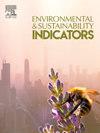埃塞俄比亚中部奥罗米亚地区北谢瓦地区地理信息系统和基于参数的咖啡场地适宜性区划
IF 5.4
Q1 ENVIRONMENTAL SCIENCES
引用次数: 0
摘要
目前正在进行若干研究,利用地理信息系统和土壤数据审查土地的适宜性。本研究利用地理信息系统和参数化决策标准绘制并评估了埃塞俄比亚中部高地咖啡种植的可持续性。该方法结合了地理、气象和土壤质量数据。我们从美国地质调查局获得了光谱和DEM数据,从EMSA获得了气候数据。为了评价咖啡种植的适宜性,我们采用基于网格和样带的分层随机抽样方法建立了120个土壤样地。样品从0到30厘米的深度范围内获得,并在实验室进行评估。使用GIS和多标准决策分析生成适宜性指标,并使用story和平方根方法评估地形、气候和土壤适宜性。我们的研究结果显示,阿拉比卡咖啡可能种植在中央高地,根据最低咖啡生产标准,大约27%(303,421.5公顷)的土地被划分为高度到边缘适宜(S1-S3)。相反,该地区73%的土地(821213公顷)被评为不适合种植,原因是温度较低或主要的生产限制。我们的方法还有效地评估了目前在高海拔地区种植咖啡的适宜性,以前人们认为这些地区不可能种植咖啡。我们的结论是,我们的研究结果有可能影响咖啡生产者、政策制定者和专家,通过确定可行的土地适宜性等级,为高原地区的咖啡生产提供资源,这些土地适宜性等级可以从可持续和高产咖啡种植的改进工作中受益。本文章由计算机程序翻译,如有差异,请以英文原文为准。
Gis and parametric based coffee site suitability zonation in North Shewa zone of Oromia region, central Ethiopia
Several studies are now being undertaken to examine land suitability using GIS and soil data. This study mapped and assessed the sustainability of coffee farming in Ethiopia's central highlands using GIS and parametric decision-making criteria. The method combined geographic, meteorological, and soil quality data. We obtained spectral and DEM data from the USGS and climate data from EMSA. To evaluate soil suitability for coffee, we established 120 soil plots using a stratified random sampling method based on grids and transects. Samples were obtained from depths ranging from 0 to 30 cm and evaluated in the laboratory. The suitability metrics were generated using GIS and multi-criteria decision-making analysis, with the Storie and square root methods used to assess topographic, climatic, and soil suitability. Our findings revealed that Arabica coffee may be grown in the central highlands, with approximately 27 % (303,421.5 ha) of land classified as highly to marginally suitable (S1-S3) based on minimal coffee production standards. Conversely, 73 % of the region's land (821213 ha) was rated unsuitable due to lower temperatures or major production constraints. Our methodology also effectively assessed the suitability of present coffee-growing areas at higher elevations, where it was previously thought that coffee could not be grown. We conclude that our findings have the potential to influence coffee producers, policymakers, and specialists, serving as a resource for coffee production in highland areas by identifying viable land suitability classes that could benefit from improvement efforts for sustainable and productive coffee farming.
求助全文
通过发布文献求助,成功后即可免费获取论文全文。
去求助
来源期刊

Environmental and Sustainability Indicators
Environmental Science-Environmental Science (miscellaneous)
CiteScore
7.80
自引率
2.30%
发文量
49
审稿时长
57 days
 求助内容:
求助内容: 应助结果提醒方式:
应助结果提醒方式:


